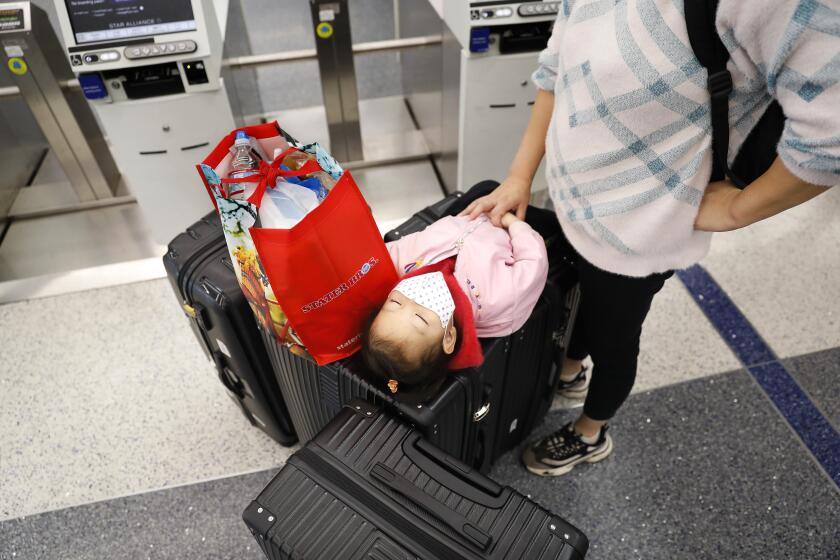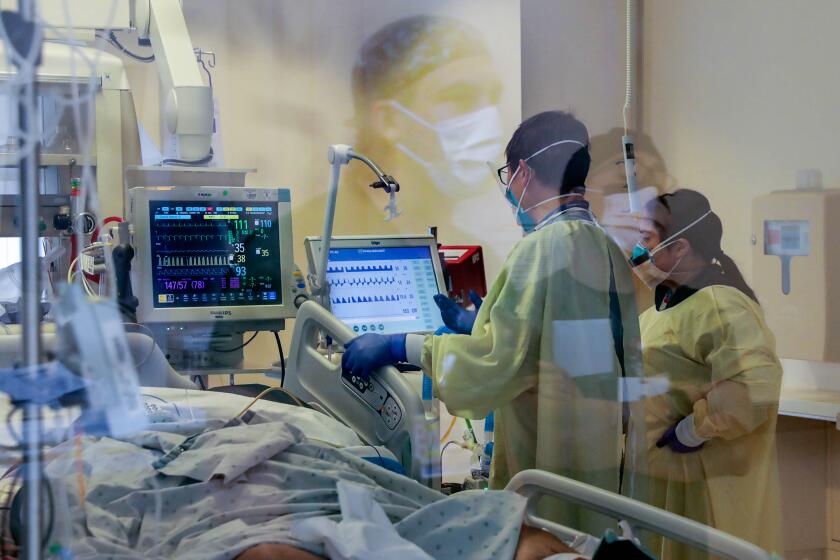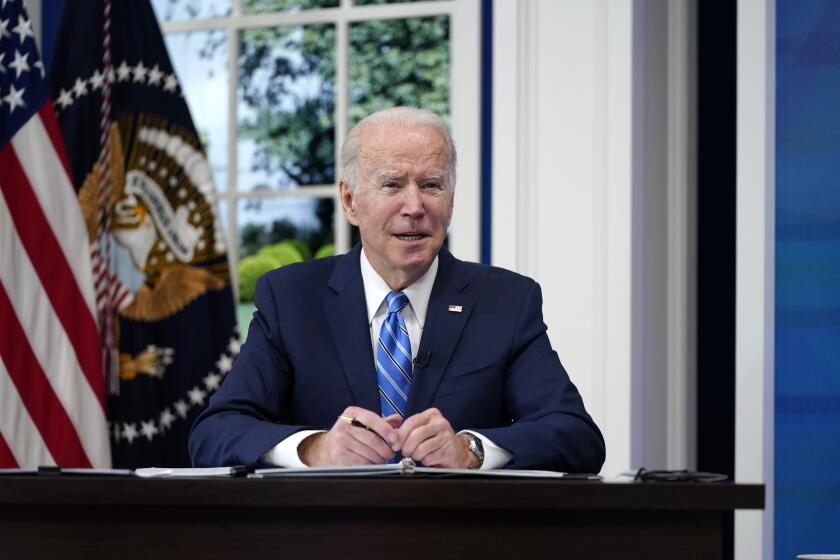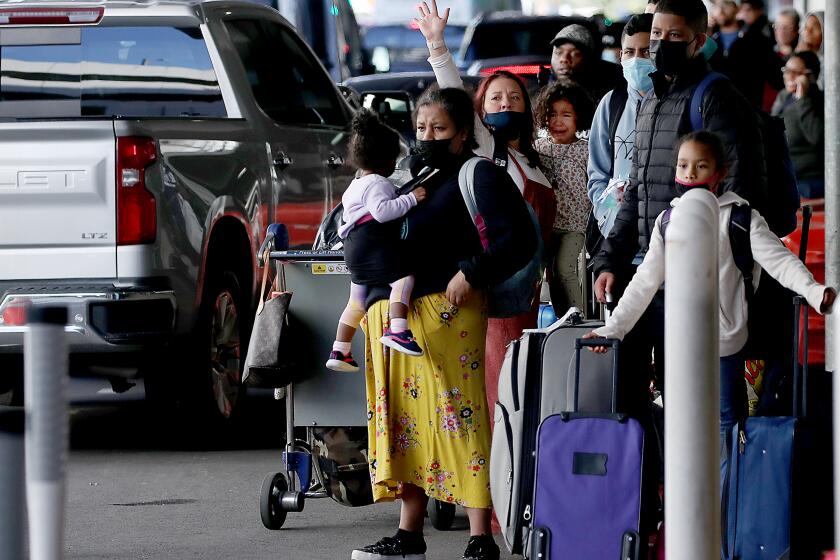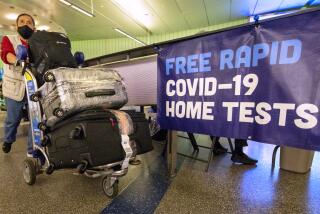Omicron ‘going to get worse before it gets better’ as California hospitalizations rise
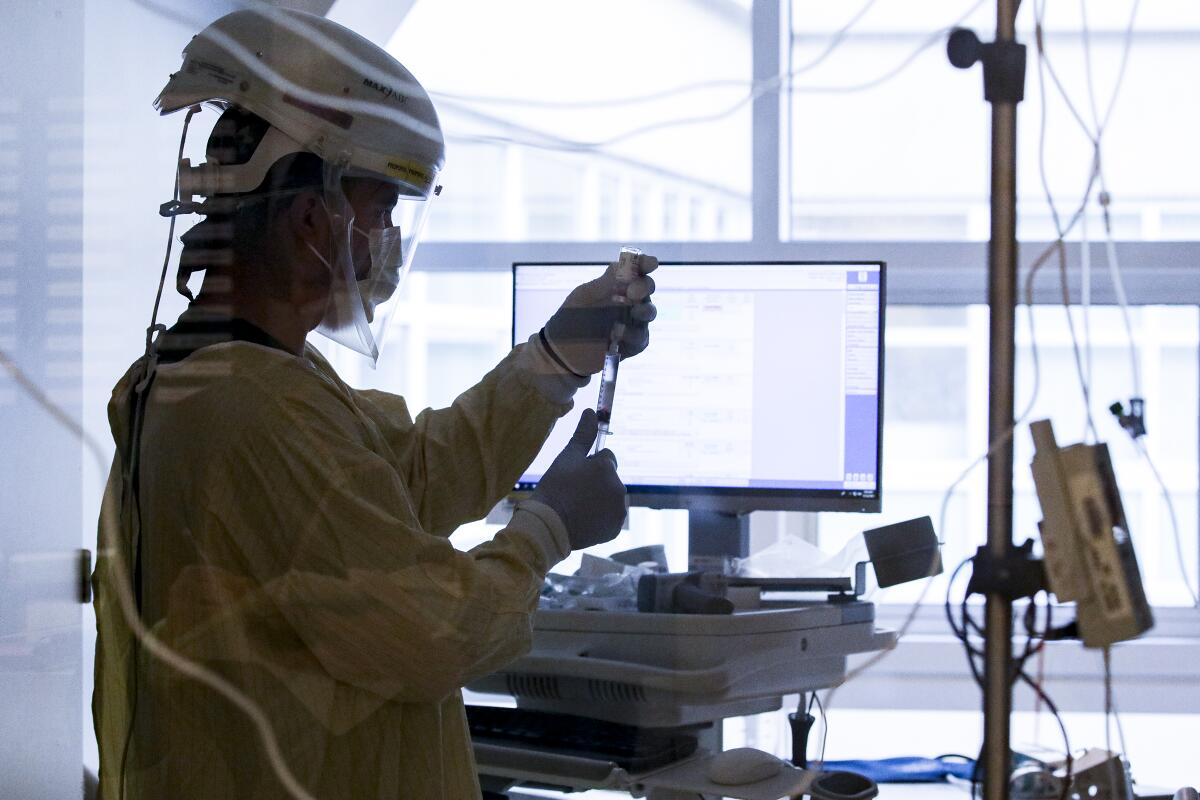
- Share via
The number of COVID-19 patients hospitalized in California over the weekend reached levels not seen in months as the rapid spread of the Omicron variant caused major airline interruptions and sent throngs of people to testing sites.
Officials said they expected Omicron’s spread to worsen in the coming weeks, with President Biden promising the federal government will do all it can to assist states facing surges in coronavirus cases. Biden acknowledged those who faced long waits for tests over the holiday and said his administration was seeking to alleviate the issue.
“Seeing how tough it was for folks to get a test this weekend shows we have more work to do,” Biden said, “and we’re doing it.”
There were 4,001 coronavirus patients hospitalized Sunday — California’s highest single-day total since Oct. 9 and a nearly 14% increase from last week.
Some areas are contending with even sharper rises. Los Angeles County has seen a 30% bump in COVID-19 hospitalizations since last week. In Orange County, the patient count has swelled nearly 45% during the same period.
Overall, the greater Southern California and Sacramento regions have posted a 20% jump in hospitalizations during the same span, while the San Francisco Bay Area has recorded a 13% increase.
Officials and experts have long noted that hospitalizations are a lagging indicator of coronavirus spread, usually rising about two weeks after increases in infections.
That’s a potentially worrisome trend, given that California is battling a significant new spike that officials say is driven by circulation of the Omicron variant, perhaps the most heavily mutated and highly transmissible edition of the coronavirus.
Over the last week, California reported an average of 11,914 new coronavirus cases per day, a 73% jump from two weeks ago, according to data compiled by The Times.
The surge has been especially profound in Los Angeles County, which announced more than 20,000 combined new cases Saturday and Sunday — an eye-popping total officials say is actually an undercount because of reporting lags over the Christmas weekend.
Health officials in the nation’s most populous county reported 7,425 new cases Monday. This, too, is likely an undercount, they said.
A combination of coronavirus-related illness among airline crews and bad weather brought another day of headaches at airports. More than 1,070 flights were canceled within, into or out of the U.S. on Monday, and upward of 2,710 were stopped around the world for the day, according to FlightAware. That’s a slight improvement over the previous day, when there were 1,517 cancellations nationally and 3,274 globally.
Dozens of flights were scrapped Monday at LAX, and hundreds were canceled nationally after a weekend of holiday travel woes.
It remains to be seen how many recently infected Californians will fall ill enough to require professional care. There are promising data that Omicron may cause less-severe symptoms than the Delta variant, the culprit behind last summer’s coronavirus surge.
But that may not be enough to shield healthcare systems from being stretched to their limits, especially in regions where vaccination rates are low.
Evidence continues to mount that vaccinated people who have received their booster shot, but still get infected, generally have no or mild symptoms, according to Dr. Anthony Fauci, President Biden’s chief medical adviser.
But Fauci, speaking during an appearance on ABC’s “Good Morning America,” said he remains concerned about severe illness among the unvaccinated.
‘We are heading into very challenging times over the winter holidays,’ says Los Angeles County Public Health Director Barbara Ferrer.
Nationwide, just under 62% of Americans are fully vaccinated, according to the Centers for Disease Control and Prevention. In California, that figure is a tad above 67%.
That inoculation coverage, however, leaves millions who can still easily fall prey to the coronavirus.
“We still have tens of millions of unvaccinated people, and we’re seeing hospitalizations rise,” Biden said during a briefing call with state governors Monday. “It means our hospitals in some places are going to get overrun, both in terms of equipment and staff.”
As the variant spreads, businesses across California are rethinking return-to-office timelines and scrambling to cope with lost productivity.
From Dec. 2-8 — the week after Omicron was first detected in the state — unvaccinated Californians were nearly eight times more likely to be infected than their fully vaccinated counterparts, state data show.
And over the weeklong period ending Dec. 11, unvaccinated people in L.A. County were 23 times more likely to be infected than vaccinated people who had received a booster shot, officials said.
Aside from the potential for severe illness, officials also note that every new infection gives the coronavirus another chance to evolve, potentially in ways that cause it to spread more easily or evade the protective power of vaccines.
“The reason why we all want to minimize transmission, even if it’s mild illness, is every time this virus infects an individual, it has a chance to mutate,” said Dr. Regina Chinsio-Kwong, a deputy health officer for Orange County.
In meeting with COVID response team and U.S. governors, Biden reiterates his plan to make 500 million rapid tests available to Americans next month.
Fauci said the Omicron surge is likely to get worse before getting better.
While cases are declining in South Africa, where Omicron was first detected, they’re still going up in Britain — which usually presages trends in the U.S. And Britain’s hospitals have been strained.
“In other words, what happens there generally happens here a couple to three weeks later,” Fauci said. “The way it’s going up right now — it’s going to get worse before it gets better. We don’t expect things are going to turn around in a few days to a week. It likely will take much longer than that, but that’s unpredictable.”
Fauci said medical officials in South Africa also are reporting more hospitalizations among children infected with the coronavirus, echoing data out of New York, which is seeing a jump in pediatric hospitalizations, most among children who aren’t fully vaccinated.
“That’s one of the reasons why we say … if you have a child from 5 to 11, to please get that child vaccinated to prevent them from getting anything that even resembles a serious illness,” he said.
In metro New York, half of the children being admitted to hospitals are younger than 5 and ineligible for vaccination. California health officials see this as a warning to get more children vaccinated.
Data released Monday by Dr. Mary Bassett, New York’s acting health commissioner, showed that new pediatric hospitalizations quintupled in New York City in recent weeks. From Dec. 5-11, there were 22 pediatric COVID hospitalizations reported; for the partial week of Dec. 19-23, there were 109.
Earlier data released Friday showed that all the children ages 5 to 11 and three-quarters of those ages 12 to 17 who were hospitalized were not fully vaccinated. Half of the children being admitted to hospitals are younger than 5 and ineligible for vaccination.
In New York, 27% of children 5 to 11 have received at least one dose of vaccine, and 16% have received two doses. Those numbers are similar to California’s, which are 25% and 16%, respectively.
“Many people continue to think that children don’t become infected with COVID. This is not true. Children become infected, and some will be hospitalized,” Bassett said at a briefing Monday. “We need to get child vaccinations up. We need to get them higher than they are, particularly in the 5- to 11-year-old age group.”
Meanwhile, U.S. health officials on Monday cut isolation restrictions for Americans infected with the coronavirus from 10 to five days, and similarly shortened the time that close contacts of infected people need to quarantine.
The CDC said the guidance is in keeping with growing evidence that people who catch the coronavirus are most infectious in the two days before and three days after symptoms, if any, develop.
Times staff writers Anumita Kaur in Washington and Lila Seidman and Hugo Martín in Los Angeles and the Associated Press contributed to this report.
More to Read
Sign up for Essential California
The most important California stories and recommendations in your inbox every morning.
You may occasionally receive promotional content from the Los Angeles Times.
